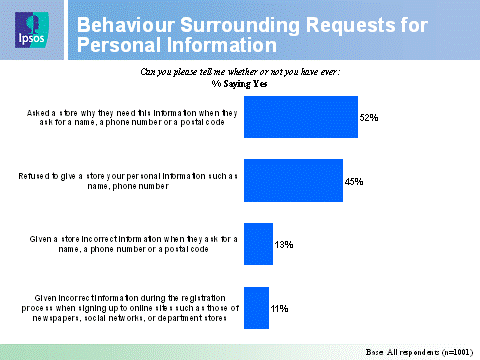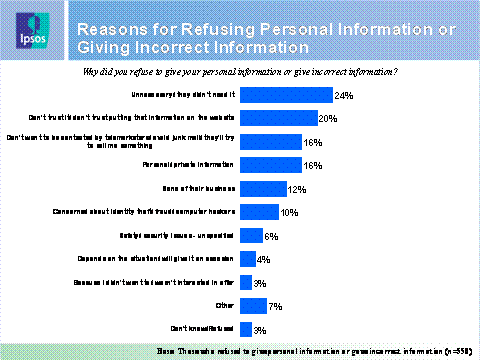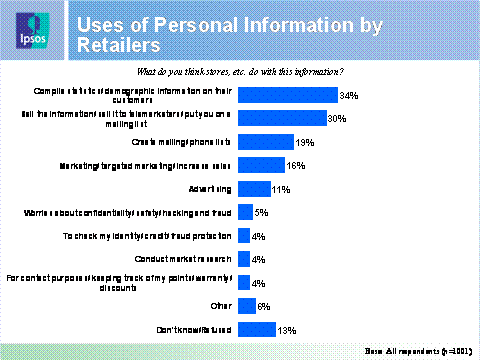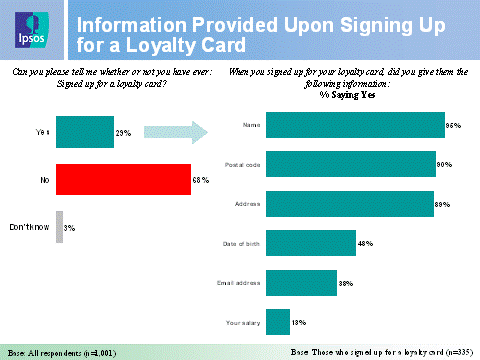Public opinion survey
This page has been archived on the Web
Information identified as archived is provided for reference, research or recordkeeping purposes. It is not subject to the Government of Canada Web Standards and has not been altered or updated since it was archived. Please contact us to request a format other than those available.
The Personal Information Canadians Give to Retailers
Final Report
Submitted to:
The Office of the Privacy Commissioner of Canada
January 2008
Ipsos-Reid Corporation
Research Purpose
The purpose of this research is to add to the Office of the Privacy Commissioner’s (OPC) understanding of the demands placed upon Canadians for personal information during retail transactions, and to help OPC evaluate the need for detailed public education and outreach campaigns to inform Canadians about the appropriate application of the Personal Information Protection and Electronic Documents Act (PIPEDA) during retail transactions. It will also inform OPC’s policy, research and analysis activities, and indicate if further guidance or interpretive materialis necessary for retailers, their associations or consumers to ensure Canadians are protected and PIPEDA is respected.
Methodology
The methodology for this research involved placing questions on the Canadian Ipsos-Reid Express (CIRE) telephone omnibus. The CIRE delivers a nationally representative sample of approximately 1000 adult Canadians each week. The sample size for this research is n=1001 resulting in a margin of error of ± 3.1 percentage points, 19 times out of 20. Interviewing took place from December 11 to 16, 2007.
The following tables sets out the sample size and associated margin of error for each region:
Region |
Sample Size n=1,000 |
Margin of ErrorFootnote * |
|---|---|---|
|
British Columbia |
131 | ±8.6 |
|
Alberta |
104 | ±9.6 |
|
Manitoba/Saskatchewan |
65 | ±12.2 |
|
Ontario |
381 | ±5.0 |
|
Quebec |
250 | ±6.2 |
|
Atlantic Canada |
70 | ±11.7 |
|
Canada |
1,001 | ±3.1 |
Key Findings
One in two respondents (52%) resist requests for personal information (e.g. name, phone number, or postal code) from retailers by asking why this information is needed while close to half (45%) refuse to provide this information altogether. Providing false information is done less often, however about one ten admit to providing a store/social network/newspaper with incorrect information either in-person (13%) or online (11%) in the past.
A major impetus for the refusal of personal information or the provision of false information involves safety or security concerns. This includes a general sense of distrust regarding what will happen with this information (20%), concern about identity theft, fraud, and computer hackers (10%), and security/safety issues in general (6%). Other reasons for not disclosing this information include that this information is considered to be personal/private/none of their business (28%), that providing this information is unnecessary (24%), and to avoid being contacted by telemarketers, sent junk mail, or solicited to buy something (16%).
When respondents were asked what they think retailers do with this type of information, three in ten (30%) say that it is sold to telemarketers or other companies who wish to use this information for marketing purposes. Otherwise, respondents feel that retailers are using this information for their own marketing purposes, either to compile statistics or demographic information on their customers (34%), to create their own mailing or phone lists (19%), for targeted marketing purposes/to increase sales (16%), for advertising (11%), or to conduct marketing research (4%).
Three in ten (29%) respondents have signed up for a loyalty card in the past. Name (95%), postal code (90%), and address (89%) were provided by virtually everyone who did so while supplying date of birth (48%) and e-mail address (38%) was done less often. Relatively few (13%) gave their annual salary as part of this process.
Detailed Findings
Behaviour Surrounding Requests for Personal Information
Half of respondents (52%) have asked a store why they need this information when asked for their name, phone number, or postal code while close to half (45%) have refused to provide such information upon request.
Relatively few respondents have provided incorrect information when asked for a name, phone number, or postal code by a retailer (13%) or during the registration process when signing up to online sites such as those of newspapers, social networks, or department stores (11%).

Those most likely to have asked a store why they need this information when asked for a name, phone number, or postal code are:
- Those with higher levels of education (peaking at 60% among those with a university education or higher);
- Residents of Ontario (59%) compared to those in British Columbia (46%) and Quebec (46%); and
- Urban dwellers (55%) compared to those living in rural areas (40%).
Those most likely to have refused to give a store their personal information such as name and phone number are:
- Those with higher levels of education (peaking at 55% among those with a university education or higher);
- Those earning $30,000 to less than $60,000 a year (47%) compared to those earning less than $30,000 a year (37%); and
- Men (49% vs. 41% among women).
Those most likely to have given incorrect information when asked for a name, phone number, or postal code are:
- Younger respondents (peaking at 19% among those 18 to 34 years old);
- Residents of British Columbia (19%) compared those in Quebec (9%); and
- Men (16% vs. 10% among women).
Those most likely to have given incorrect information during the registration process when signing up to online sites such as those of newspapers, social networks, or department stores are:
- Younger respondents (peaking at 22% among those 18 to 34 years old);
- Those with higher levels of education (peaking at 19% among those with a university education or higher);
- Those with higher levels of income (peaking at 16% among those with a household income of $60,000 or more a year);
- Men (15% vs. 8% among women); and
- Urban dwellers (13%) compared to those living in rural areas (7%).
Reasons for Refusing Personal Information or Giving Incorrect Information
When those who have either given incorrect personal information or refused to give such information were asked why they did so comments related to security/safety issues were mentioned most often including a general sense of distrust in providing such information or inputting such information online (20%), concern about identity theft, fraud, and computer hackers (10%), and mentions of safety/security issues in general (6%). Other reasons include that it is unnecessary (24%), and to avoid being contacted by telemarketers, sent junk mail, or solicited to buy something (16%).
A significant proportion of respondents refrained from providing their personal information for no other reason than it is personal/private (16%) or because it is considered to be “none of their business” (12%).

Those with higher levels of income (peaking at 33% among those with annual household incomes of $60,000 or more) and education (peaking at 29% among those with a university education or higher) are more likely than their respective counterparts to say that they refused to give their personal information or that they gave incorrect information because it is unnecessary/stores do not need it.
Younger respondents (peaking at 24% among those 18 to 34 years old), those with higher levels of education (peaking at 23% among those with a university education or higher), and residents of Ontario (22%), compared to those in Alberta (8%) and Atlantic Canada (6%) are more likely to say that they refused to provide their personal information or gave incorrect information because they didn’t want to be contacted by telemarketers/to avoid junk mail/ to avoid being sold something.
Older respondents (peaking at 23% among those 55 years or older) are more likely than younger Canadians to say that they did not provide their personal information because it is “none of their business”.
Uses of Personal Information by Retailers
When asked what they think stores do with the personal information of customers the major mentions include: to compile statistics or demographic information on their customers (34%), to sell to companies for marketing purposes (i.e. telemarketers, mailing lists) (30%), to create mailing or phone lists (19%), for marketing purposes to increase sales (16%), or for advertising purposes (11%).

Those most likely to say that stores use this information to compile statistics/demographics on their customers are:
- Those with some post secondary education (39%) or higher (37%) compared to those with less than a high school education (22%); and
- Younger respondents (peaking at 39% among those 18 to 34 years old).
Residents of British Columbia (43%), particularly compared to those in Ontario (30%), Quebec (21%), and Atlantic Canada (25%), and older respondents (peaking at 37% among those 55 years of age or older) are more likely to say that stores sell this information to telemarketers or to other companies for the creation of mailing lists.
Loyalty Cards
Nearly three in ten (29%) respondents have signed up for a loyalty card in the past.
Of those who have done so high proportions of respondents provided their name (95%), postal code (90%), and/or address (89%) at the time. Significantly fewer provided their date of birth (48%), followed by two in five (38%) who provided their e-mail address.
Only 13 percent of respondents provided their salary when signing up for a loyalty card in the past.

Those most likely to have signed up for a loyalty card in the past are:
- Those with higher levels of education (peaking at 44% among those with a university education or higher);
- Those with higher levels of income (peaking at 39% among those with a household income of $60,000 or more a year);
- Residents of British Columbia (35%) compared to those in Atlantic Canada (19%);
- Those 35 to 54 years old (34%) compared to those 55 years or older (25%); and
- Urban dwellers (31%) compared to those living in rural areas (23%).
Residents of Ontario are more likely than those in other regions such as Quebec, and in some cases Alberta, and British Columbia to have provided their name, address, postal code, and e-mail address when signing up for a loyalty card. Those in Quebec are more likely than residents of British Columbia and Ontario to have provided their date of birth. Younger respondents (18 to 34 years) are more likely than their older counterparts to have provided their date of birth and e-mail address in particular.
Appendix I – Topline Results
1. YES SUMMARY TABLE
| TOTAL | |
|
Base: All Respondents
|
|
|
Unweighted Base
|
1001 |
|
Weighted Base
|
1001 |
|
1) Given a store incorrect information when they ask for a name, a phone number or a postal code
|
13% |
|
2) Asked a store why they need this information when they ask for a name, a phone number or a postal code
|
52% |
|
3) Refused to give a store your personal information such as name, phone number
|
45% |
|
4) Given incorrect information during the registration process when signing up to online sites such as those of newspapers, social networks, or department stores
|
11% |
|
5) Signed up for a loyalty card
|
29% |
1. NO SUMMARY TABLE
| TOTAL | |
|---|---|
|
Base: All Respondents
|
|
|
Unweighted Base
|
1001 |
|
Weighted Base
|
1001 |
|
1) Given a store incorrect information when they ask for a name, a phone number or a postal code
|
87% |
|
2) Asked a store why they need this information when they ask for a name, a phone number or a postal code
|
47% |
|
3) Refused to give a store your personal information such as name, phone number
|
55% |
|
4) Given incorrect information during the registration process when signing up to online sites such as those of newspapers, social networks, or department stores
|
87% |
|
5) Signed up for a loyalty card
|
68% |
1. Can you please tell me whether or not you have ever: 1) Given a store incorrect information when they ask for a name, a phone number or a postal code?
| TOTAL | |
|
Base: All respondents
|
|
|
Unweighted Base
|
1001 |
|
Weighted Base
|
1001 |
|
Yes
|
13% |
|
No
|
87% |
|
Don't know/Refused
|
0 |
1. Can you please tell me whether or not you have ever: 2) Asked a store why they need this information when they ask for a name, a phone number or a postal code?
| TOTAL | |
|
Base: All respondents
|
|
|
Unweighted Base
|
1001 |
|
Weighted Base
|
1001 |
|
Yes
|
52% |
|
No
|
47% |
|
Don't know/Refused
|
1% |
1. Can you please tell me whether or not you have ever: 3) Refused to give a store your personal information such as name, phone number?
| TOTAL | |
|
Base: All respondents
|
|
|
Unweighted Base
|
1001 |
|
Weighted Base
|
1001 |
|
Yes
|
45% |
|
No
|
55% |
|
Don't know/Refused
|
0 |
1. Can you please tell me whether or not you have ever: 4) Given incorrect information during the registration process when signing up to online sites such as those of newspapers, social networks, or department stores?
| TOTAL | |
|
Base: All respondents
|
|
|
Unweighted Base
|
1001 |
|
Weighted Base
|
1001 |
|
Yes
|
11% |
|
No
|
87% |
|
Don't know/Refused
|
1% |
1. Can you please tell me whether or not you have ever: 5) Signed up for a loyalty card?
| TOTAL | |
|
Base: All respondents
|
|
|
Unweighted Base
|
1001 |
|
Weighted Base
|
1001 |
|
Yes
|
29% |
|
No
|
68% |
|
Don't know/Refused
|
3% |
2. Why did you refuse to give your personal information or give incorrect information?
| TOTAL | |
|---|---|
|
TOTAL MENTIONS
|
|
|
Base: Refused to give your personal information or give incorrect information
|
|
|
Unweighted Base
|
558 |
|
Weighted Base
|
531 |
|
Unnecessary/ they didn't need it
|
24% |
|
Don't trust it/ don't trust putting that information on the website
|
20% |
|
Don't want to be contacted by telemarketers/ avoid junk mail/ they'll try to sell me something
|
16% |
|
Personal/ private information
|
16% |
|
None of their business
|
12% |
|
Concerned about identity theft/ fraud/ computer hackers
|
10% |
|
Safety/ security issues - unspecified
|
6% |
|
Depends on the situation/ will give it on occasion
|
4% |
|
Because I didn't want to/ wasn't interested in offer
|
3% |
|
I didn't refuse
|
3% |
|
Other
|
7% |
|
None/ no reason
|
0 |
|
Don't know/Refused
|
3% |
3. YES SUMMARY TABLE
| TOTAL | |
|
Base: Signed up for a loyalty card
|
|
|
Unweighted Base
|
335 |
|
Weighted Base
|
295 |
|
1) Date of birth
|
48% |
|
2) Name
|
95% |
|
3) Address
|
89% |
|
4) Postal code
|
90% |
|
5) Email address
|
38% |
|
6) Your salary
|
13% |
3. NO SUMMARY TABLE
| TOTAL | |
|
Base: Signed up for a loyalty card
|
|
|
Unweighted Base
|
335 |
|
Weighted Base
|
295 |
|
1) Date of birth
|
39% |
|
2) Name
|
4% |
|
3) Address
|
9% |
|
4) Postal code
|
9% |
|
5) Email address
|
60% |
|
6) Your salary
|
85% |
3. When you signed up for your loyalty card, did you give them the following information: 1) Date of birth?
| TOTAL | |
|
Base: Signed up for a loyalty card
|
|
|
Unweighted Base
|
335 |
|
Weighted Base
|
295 |
|
Yes
|
48% |
|
No
|
39% |
|
Don't know/Refused
|
13% |
3. When you signed up for your loyalty card, did you give them the following information: 2) Name?
| TOTAL | |
|
Base: Signed up for a loyalty card
|
|
|
Unweighted Base
|
335 |
|
Weighted Base
|
295 |
|
Yes
|
95% |
|
No
|
4% |
|
Don't know/Refused
|
1% |
3. When you signed up for your loyalty card, did you give them the following information: 3) Address?
| TOTAL | |
|
Base: Signed up for a loyalty card
|
|
|
Unweighted Base
|
335 |
|
Weighted Base
|
295 |
|
Yes
|
89% |
|
No
|
9% |
|
Don't know/Refused
|
2% |
3. When you signed up for your loyalty card, did you give them the following information: 4) Postal code?
| TOTAL | |
|
Base: Signed up for a loyalty card
|
|
|
Unweighted Base
|
335 |
|
Weighted Base
|
295 |
|
Yes
|
90% |
|
No
|
9% |
|
Don't know/Refused
|
2% |
3. When you signed up for your loyalty card, did you give them the following information: 5) Email address?
| TOTAL | |
|
Base: Signed up for a loyalty card
|
|
|
Unweighted Base
|
335 |
|
Weighted Base
|
295 |
|
Yes
|
38% |
|
No
|
60% |
|
Don't know/Refused
|
2% |
3. When you signed up for your loyalty card, did you give them the following information: 6) Your salary?
| TOTAL | |
|
Base: Signed up for a loyalty card
|
|
|
Unweighted Base
|
335 |
|
Weighted Base
|
295 |
|
Yes
|
13% |
|
No
|
85% |
|
Don't know/Refused
|
3% |
4. What do you think stores, etc. do with this information?
| TOTAL | |
|---|---|
|
TOTAL MENTIONS
|
|
|
Base: All respondents
|
|
|
Unweighted Base
|
1001 |
|
Weighted Base
|
1001 |
|
Compile statistics/ demographic information on their customers
|
34% |
|
Sell the information/ sell it to telemarketers/ put you on a mailing list
|
30% |
|
Create mailing/ phone lists
|
19% |
|
Marketing/ targeted marketing/ increase sales
|
16% |
|
Advertising
|
11% |
|
Worries about confidentiality/ safety/ hacking and fraud
|
5% |
|
To check my identity/ credit/ fraud protection
|
4% |
|
Conduct market research
|
4% |
|
For contact purposes/ keeping track of my points/ warranty/ discounts
|
4% |
|
Other
|
6% |
|
Don't know/Refused
|
13% |
Alternate versions
- PDF (97 KB) Not tested for accessibility
- Date modified:

